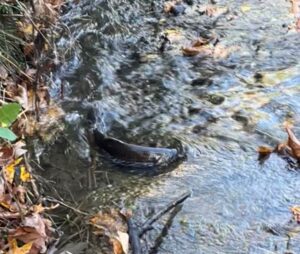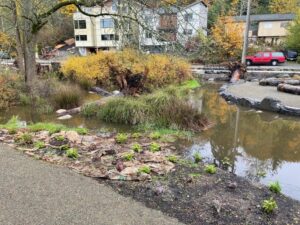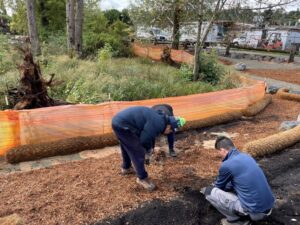6PPD: How it harms salmon and what DNDA is doing to help

A coho salmon returning to Longfellow Creek to spawn struggles to swim upstream after traveling hundreds of miles to its final destination.
When rain falls, as it did on 120 days in Seattle last year, it usually lands on hard surfaces, like sidewalks, streets, rooftops, and cars. As it makes its way toward storm drains, the water carries pollution from microplastics, fertilizers, trash, tires, and other contaminants.
Normally, this rainwater is collected and cleaned by wastewater treatment systems before entering creeks or rivers. However, during exceptionally rainy periods — which are increasing in frequency and severity due to climate change — untreated stormwater can exceed the capacity of treatment systems and go directly into our waterways, an event called combined sewer overflow.
As our city works to adapt and solve this issue, some of our wildlife struggle.
Currently, 14 population groups of salmon species in Washington are listed under the federal Endangered Species Act. Scientists track these populations closely because of their status, and they have found that certain salmon species in urban creeks die before spawning at much higher levels than those in rural creeks, especially coho salmon. But they did not know the cause.
After years of research, a team of experts from several institutions around Washington state uncovered the killer — a previously undiscovered toxic chemical released by car tires all over the world called 6PPD-quinone. The findings were published in the journal Science in December 2020.
What is 6PPD?
6PPD is a chemical added to tires and other rubber products used to prevent degradation over time. It is named by its components — six carbon atoms and a molecule called phenyl phenylenediamine.
When 6PPD reacts with certain atmospheric gases, it generates a chemical compound called 6PPD-quinone (pronounced “kwih-known”), referred to in short as 6PPD-q.
As tires wear down on roads, they slowly release particles containing 6PPD-q. Once 6PPD-q is on our roads, rain picks it up and transports it into our local stormwater system, including rivers, streams, and Puget Sound.
Identifying the Threat
Researchers spent two decades investigating the cause of coho salmon dying at abnormally high rates in urban waterways with their eggs still intact — a phenomenon called pre-spawn mortality. Scientists tested numerous theories, including high water temperatures, pathogens, low oxygen levels, and thousands of common pollutants. Everything was a dead-end, until 6PPD-q.
The first sign of scientific progress was made in 2017, when researchers found a correlation between salmon mortality rates and vehicle traffic, leading them to speculate that the toxin was coming from roadways and ending up in stormwater runoff. It took years after making this initial connection for scientists to identify 6PPD-q as the specific chemical responsible.

Coho salmon have distinctive silver sides and dark metallic blue or green backs. Photo by NOAA Fisheries.
Harm to Salmon
6PPD-q is estimated to be responsible for killing 40 to 90 percent of coho salmon returning to Puget Sound to spawn. Salmon in Seattle’s urban waterways, like our local Longfellow Creek, can die within hours of being exposed to 6PPD-q, often by swimming in an area where the chemical is especially concentrated.
Shortly after being exposed, coho experience disorientation, loss of swimming ability, and gasping at the surface of the water. This illness, called Urban Runoff Mortality Syndrome, prevents coho from reproducing and rebuilding their declining population. Research shows that coho are more sensitive to 6PPD-q compared to some other salmon species.
The decline of coho salmon also negatively affects humans and other wildlife. Salmon are the primary food source for the endangered Southern Resident orcas that reside in Puget Sound. Coho are also integral to the culture and diet of Indigenous communities across the Puget Sound region, and some local tribes from the area have been advocating for the eradication of 6PPD from the United States entirely.
While tire manufacturers have not yet identified any alternatives to 6PPD that meet environmental health standards, organizations dedicated to nature preservation and restoration are taking steps to reduce the harmful effects that polluted stormwater runoff has on our local ecosystems.
DNDA Acts
About seven years ago, Delridge Neighborhoods Development Association (DNDA) began a community project to restore a former Seattle City Light substation into a wetland. Delridge Wetland Park — located at 23rd Avenue SW and SW Findlay Street — improves water quality in Longfellow Creek by naturally filtering out toxins. The wetland also reduces flooding and, thanks to its outdoor classroom, serves as a place for local youth to practice environmental stewardship.
Properly functioning wetlands are an essential part of urban stormwater systems because they filter and slow the movement of runoff before it can carry pollution to larger bodies of water. After construction concluded in the fall of 2023, DNDA has been performing regular maintenance at the wetland to ensure its proper functioning.
Our Nature team also uses the park as an outdoor classroom for students from nearby Louisa Boren STEM K-8 School in our Environmental STEAM Lessons program, teaching local youth about issues like 6PPD, how they can be part of the solution, and more.
This summer, the planting beds at the wetland will serve as vegetable gardens for community members. Volunteers and staff will plant wildflowers and herbaceous plants to create a native prairie habitat, and our team’s year-round maintenance of the bioswales and other infrastructure will ensure the park continues to retain and filter stormwater runoff before it enters the creek.
Get Involved
Eliminating toxins like 6PPD-q from our environment requires dedicated collaboration across federal agencies, tribal governments, scientists, corporations, interest groups, and community members. Projects like Delridge Wetland Park provide an opportunity to address an urgent problem, while improving the health of local ecosystems and benefiting the community. We hope you will join us!
DNDA’s Nature Team hosts volunteer events at Delridge Wetland Park every second Friday. Sign up to help us care for our wildlife at dnda.org/nature.
— Written by DNDA Environmental Engagement Specialist Louisa Keyani


